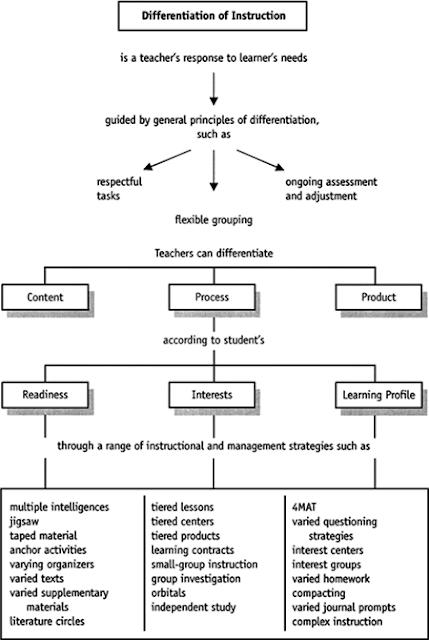Supporting All Learners with Technology
A couple of years ago, I had the opportunity to attend an ASCD conference focused on the theory and practice of Differentiation Instruction. Differentiated instruction acknowledges that students differ in their learning styles (based on Howard Gardner’s 1989 multiple intelligences - 1989), their interests and their readiness to tackle new learning tasks. As a result, teachers need to vary their teaching strategies, materials, pace and levels of supports as needed.
Differentiation, sometimes recognized by its “One Size Does Not Fit All” motto, asserts that teachers can, and indeed, must make changes in their classrooms to meet the needs of all learners.
To accomplish this, Carol Ann Tomlinson proposes that teachers can vary content, process, and product according to a student’s interests, readiness, or learning profile or learning style. As well, there are a number of different instructional and management strategies that can be employed in the classroom.
Canadian educator, Karen Hume, also explores the role of the administrator in supporting differentiation throughout the school. Karen Hume’s model for adminstrators supports her core belief that educators should work together to create the kind of learning environment that supports all students.
Online Tools to Support Learners
The meteoric rise of Web 2.0 tools provides the kinds of supports that classroom teachers need to address student differences. There are a multitude of tools for writing, reading, drawing, video, presenting, organizing, collaborating, mapping and so on. Two of my favourite sites are Cool Tools for Schools and Go2Web which put the choice of tools in the hands of students – where it belongs!
A Shift in Thinking
Using such tools requires a shift in the way teachers approach planning and teaching. Renewed curriculum in all grade levels throughout Saskatchewan has placed an important emphasis on student learning through the inquiry process. In addition, many school divisions, including Sun West, are rewriting learning outcomes into student-friendly “I can” statements, supporting students as they monitor their own learning achievements. Undoubtedly, technology can play a vitally important role in helping students not only learn, but also show what they know to others.
In May, 2011, I spoke at the IT Summit in Saskatoon about using different online technologies to differentiate. The following Slideshare is a copy of my presentation where I have highlighted a few of the sites that I have used with students in Sun West.
Assistive Technologies to Support Learners
Fortunately, for students with learning disabilities, there is an array of assistive technologies (AT) available that can help open the doors to learning. Online digital texts, like that offered in Scholastic’s Thinking Reader, provides more flexibility, and regular use of tools like language translators, text-to-speech can reach a broad range of learners. - from The Role of Technology and Design in Assisting Struggling Learners
Fortunately, for students with learning disabilities, there is an array of assistive technologies (AT) available that can help open the doors to learning. Online digital texts, like that offered in Scholastic’s Thinking Reader, provides more flexibility, and regular use of tools like language translators, text-to-speech can reach a broad range of learners. - from The Role of Technology and Design in Assisting Struggling Learners
Some educators say a “good” education is one that ensures that all students learn
certain core information and master certain competencies. Others define a “good”
education as one that helps students maximize their capacity as learners.
~ Carol Ann Tomlinson
The biggest mistake of past centuries in teaching has been to treat all children as if
they were variants of the same individual and thus to feel justified in teaching them all the
same subjects in the same way.
they were variants of the same individual and thus to feel justified in teaching them all the
same subjects in the same way.
~ Howard Gardener
For more information on Differentiated Instruction in the classroom, check out:
Adapting and Differentiating – Saskatchewan Education
Differentiated Instruction – Alberta Education
Differentiated Instruction: Professional Learning Guide – Ontario Education
Technology Supports for Differentiated Instruction – by Set Connections




Comments
Post a Comment